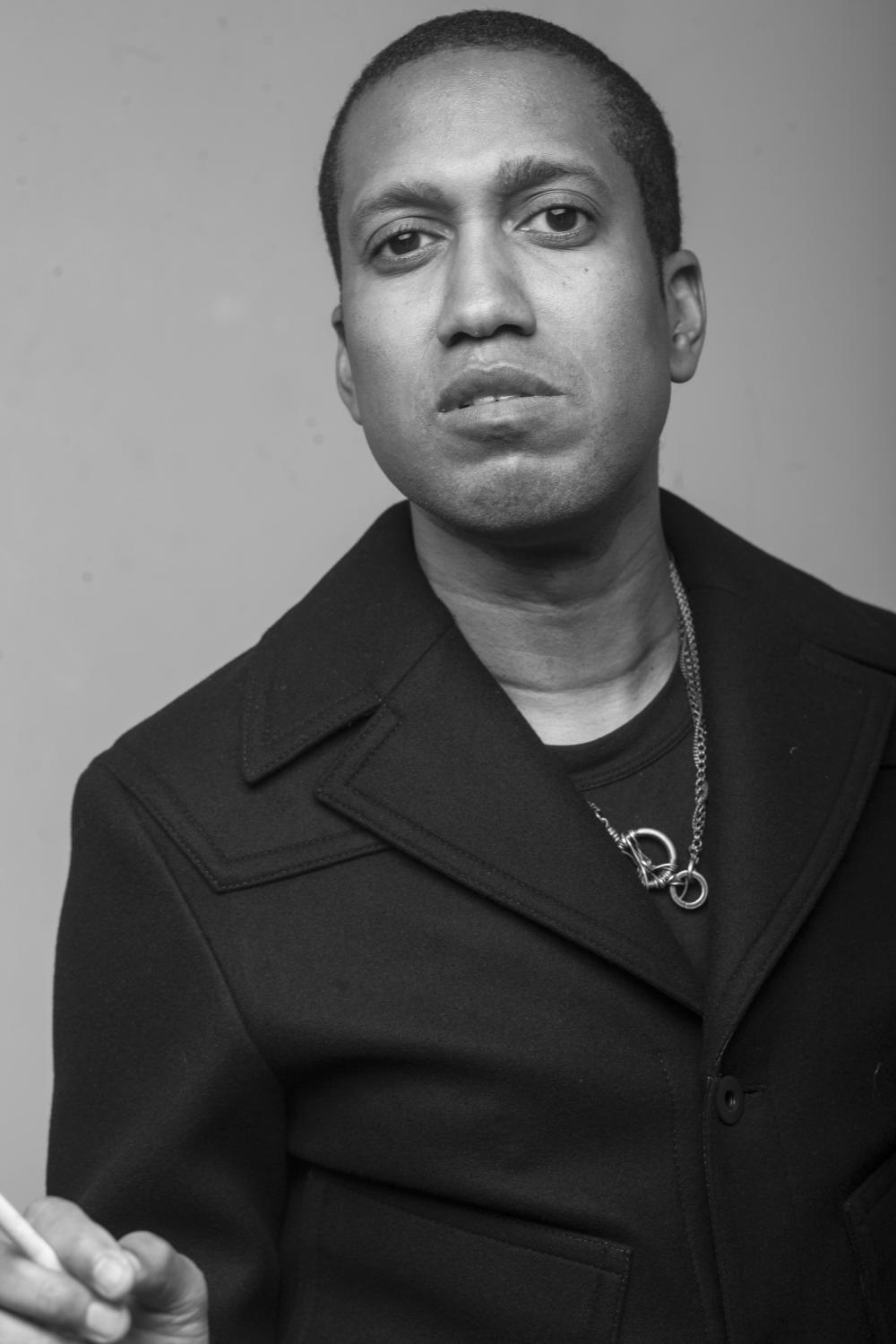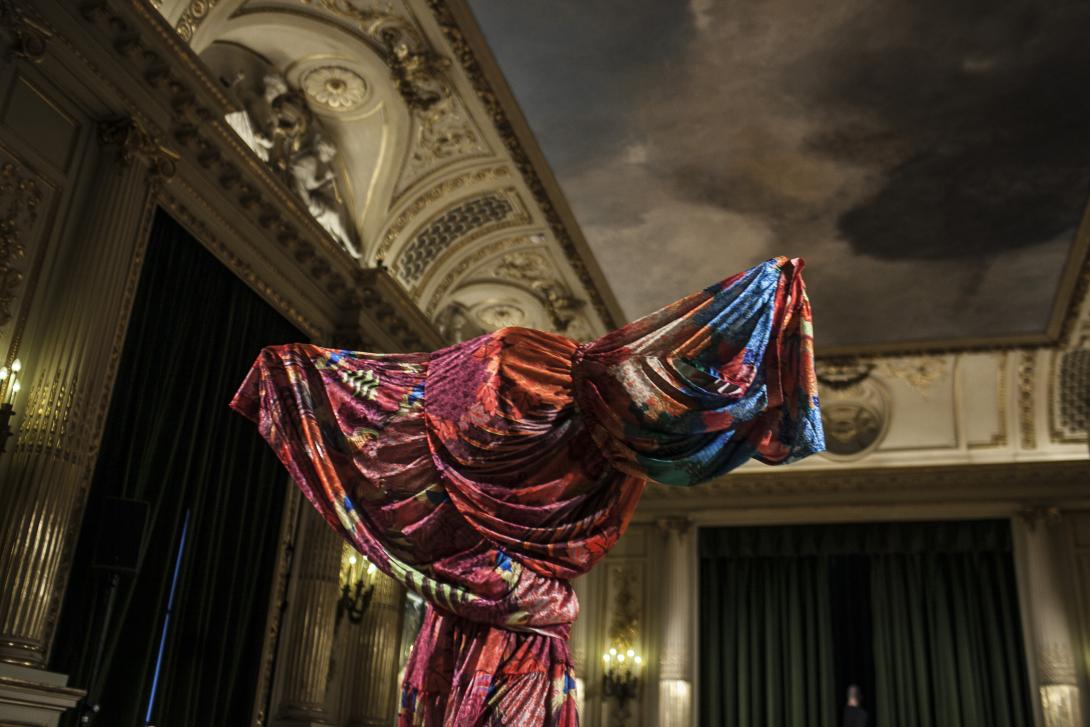“I always tend to find the cracks and fissures of history”
a conversation with Trajal Harrell
What happens when the Japanese butoh pioneer Tatsumi Hijikata meets the early 20th-century French dancer Loïe Fuller? This imaginative encounter lead the American choreograper Trajal Harrell to create his most recent work, CAEN AMOUR. Although he is always traveling, he found time to talk to us about Japan, about imagination and about history. “The most important liberation is the liberation of the imagination.”
CAEN AMOUR draws from three sources of inspiration: the French dancer Loïe Fuller, Tatsumi Hijikata, one of the pioneers of Japanese butoh, and the fashion designer Rei Kawakubo of Comme des Garçons. How do they relate to each other in the piece?
I started by imagining a meeting between Tatsumi Hijikata and Loïe Fuller. At that time, I was researching Loïe Fuller. I was already conducting long-term research on Tatsumi Hijikata and I’m continuously working with the work of Rei Kawakubo. In the process of the work, however, I decided to veil this proposition and inspiration. I wanted the work to be more experiential, inspiring the audience to physically move through the piece.
What is so fascinating about Hijikata and butoh?
My grandmother’s grandmother was from Japan, so I’ve always had an affinity with Japan. When I got a fellowship to go there, I was involved with the work of Rei Kawakubo/Comme des Garçons. My work always begins with a formal examination of the ‘défilé’, but this time I was thinking of changing my relationship with the fashion spectacle. Rei Kawakubo first came to the fashion shows in Paris in 1981 with a totally new way of designing and presenting clothes. The way people spoke about this change felt very similar for me to the way people spoke about butoh dance as being post-Hiroshima and a violent break from western ideals. During my stay in Japan, I first wanted to draw a fictional map between butoh and Rei Kawakubo to investigate possible influences between the two. I wanted to play ‘six degrees of separation’, a game based on the idea that everyone on the planet is separated by six people. I was asked to go to the archives of Hijikata, but that research method seemed too conventional. After I was asked repeatedly, however, I realized it would be rude of me not to go. I saw some recordings there of Hijikata’s pieces and I was just floored! I almost couldn’t believe the kind of aesthetic resonance and richness of the work that I discovered. I’d seen a lot of butoh but I’d never seen anything like this. Hijikata’s work didn’t come to the west, except for one excerpt that came to the Louvre, at some point during the 1980s. I understood that this was where I had to stop the mapping project. I’ve been going back to Japan regularly since then, delving into the archives and doing research. From 2013, I started to develop a set of projects around this material.
How does CAEN AMOUR fit into this research?
In my research, I was looking at how butoh started. Among other things, butoh artists were revolting against the conventions of Kabuki. The early Kabuki began with rural theatre forms. They reminded me of my own relationship to rural theatre and my first encounter with dance as a performance. When I was growing up, in a small town in Georgia, my father would take me to the fair. At a certain point during the night, he would send me off with friends and he would go to something called the hoochie coochie show. It was only when I got older that I began to realize what it meant.
I started researching the hoochie coochie and looking at its potential relationship to butoh in terms of formal practices, both from an imaginary and a realistic point of view. Butoh was highly influenced by modern dance and I think that this hoochie coochie is related to the beginnings of modern dance as well. In my research, I always tend to find the cracks and fissures of history: things that are clearly a part of (dance) history but that haven’t been fully exposed or investigated.
In bringing together these inspirations, you combine very opposing ways of dealing with the oriental. Do you mean to research it from these different perspectives?
The hoochie coochie shows were a kind of bastardization of orientalism that became watered down and turned into something else. Hijikata was trying to break away from the west. At the same time he re-inserted certain western strategies back into his work. I find this way of breaking away and re-problematizing very exciting. In CAEN AMOUR, we don’t just erase orientalism either. We try to expose it and see what it produces in the imagination, by recognizing these different historical strands and bringing them together. It’s up to the viewer to interrogate his or her own perspective on that. Instead of erasing orientalism, sexism, or racism, we try to let all of these ‘–isms’ collide in the viewer’s imagination.
By locating both dances in my personal history, I’m first of all problematizing my own relationship to orientalism and to butoh. I’m trying to find the connection for myself, which lies mainly in the imaginative. Creating art is not about a creating a definitive position on these things but proposing new or different perspectives. Of course different kinds of images can get produced, but I don’t focus on that in the making. I try to stick to the aesthetic principles and the formal concerns. It’s about how you create a terrain in which the viewer can produce different imaginative possibilities based on what he or she encounters, rather than the artist pointing it out and showing them what and how they should see. It takes a lot of trust in the aesthetic proposition and in the work. The most important liberation is the liberation of the imagination. I don’t get caught up in representation. Of course we’re critical and we are constantly challenging ourselves. But I want the work to remain productive for the viewer.
You worked around voguing in the Twenty Looks series, now you’re exploring hoochie coochie. Where does your interest in these more ‘ostracized’ or ‘unofficial’ dances come from?
People tend to focus on voguing because it is probably more exotic, but my primary interest lies in the parallel between both dances: voguing and early post-modern dance, hoochie coochie and early modern dance. I’m interested in investigating what was going on in artistic dance before it had fully formed itself into modern dance. I enjoy working in territories in which no one else is working. When I started working on Butoh, for example, it felt a bit forgotten even in Japan. As I said, I like to work in the cracks and fissures of history. Finding those places allows my imagination to grow. And I think it is an interesting proposition for all of us. Of course I’m also happy when my research might foster the acknowledgement of historical potentialities or references that were not acknowledged before.
The set is quite specific, with a forefront and a space at the back. How did the hoochie coochie show influence this set?
Usually the hoochie coochie show had a front and a back. The front was the zone of teasing but you could also go to the back to see more, such as more nakedness. In some shows you could even go to a even more hidden area with actual sex work.
I was in a two-year residency at MoMa, where I was investigating the exchange between my practice as a theatre director and my practice in making gallery works. Toward the end of this residency, I wanted to make a piece that could be seen both in theatres and museums. I used one of the key questions of my residency: How to create a sculptural experience in a dance performance? For CAEN AMOUR this sculptural experience was influenced by the hoochie coochie idea of the front and the back. It offered two kinds of experiences: the front is a kind of dance performance experience, while the experience at the back relates more to the visual arts and gallery experience.
Both front and back are negotiated through the overall formal principal of the défilé. This défilé operates in a circular form. In interaction with the audience, it creates another level of choreography: the fact that the audience can move around the piece. This means no one sees the same piece. When you see something in the back, you miss something at the front. There are therefore endless numbers of shows to be seen.
CAEN AMOUR is part of the Performatik programme, which deals with art at the intersection of the visual arts and performance. Is the set an installation or a scenography for you? And wherein does the difference lie?
I think the sculptural object is an installation and a scenography as well. By playing on both possibilities, they fuse, creating this other sculptural possibility: a kinetic sculpture, which is a choreography that the audience itself generates. If it was just an installation, I don’t think that the audience choreography would operate in the same way, and the same is true for the scenography. The tension between the two invites you to walk around kinetically in a very different kind of way.
You want to enter history through imagination as opposed to forms as re-enactment, which stay closer to the facts. You try to activate it, to make it mobile and attract new kinds of knowledge from it. Why do you treat history in this way?
History for me is like a spring board to the contemporary. It is a way to enlighten future possibilities. I think my job as an artist is to enliven the imagination and try to make us understand the power of imagination. It is one of the most important tools that we have.
It took me a while to realize that I had this specific practice of dealing with history. When I was in junior high school, there was the annual ‘History Day Competition’. There was a general theme and different categories: you could write a paper, make a display, create performances and so on. There was a different theme every year. You would take something from history and filter it through this theme. I won the Georgia History Day first place for six years in a row in group performance. It was only towards the middle of the Twenty Looks series that I realized these History Days had been crucial in my education as I had learned to take historical issues and problematize them. You could say that once I had enough grounding in the formal investigations, this historical practice came back to me as a way to enliven the imagination. But it wasn’t conscious. Like many artists, I am stumbling around in the dark. At a certain point you get to briefly turn on the light and see what’s going on, but as soon as you do that, you notice another space of darkness that you had not taken into account. So the most important thing is to be willing to research and go into the unknown. For me anyway.

